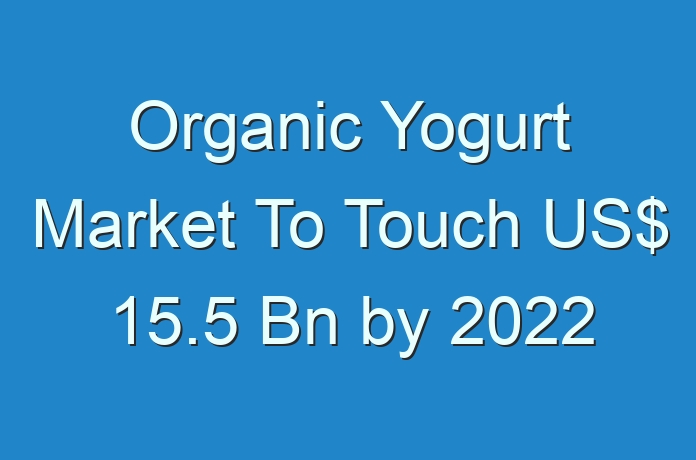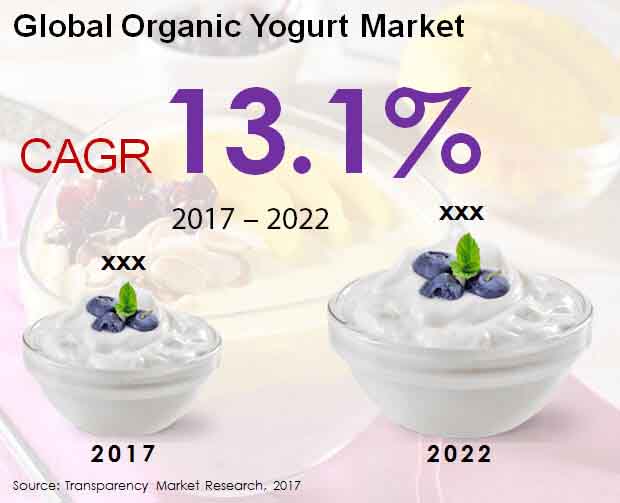
The global organic yogurt market is a chock-a-block of companies of varying sizes, finds Transparency Market Research (TMR) in a new report. Key focus of top players in the organic yogurt market is to expand their geographical outreach. To do so, savvy players are entering into partnerships and strategic alliances with regional players. Such collaborations are also helping to develop new products to serve regional taste, adds the report.
Key companies having a significant presence in the global organic yogurt market include Stonyfield Farm Inc., BJ’s Wholesale Club, Aurora Organic Dairy, Kroger Co., Safeway Inc., Ben & Jerry’s Homemade Inc., Whole Foods Market Inc., Horizon Organic Holding Corp. Purity Foods Inc., and Wallaby Yogurt Company Inc.
According to the TMR report, the global organic yogurt market is likely to expand at a stellar 13.1% CAGR for the forecast period between 2017 and 2024, for the market to be worth US$15.5 bn by 2024.
Request Brochure@
https://www.transparencymarketresearch.com/sample/sample.php?flag=B&rep_id=33146
Among the key distribution channel, specialty stores holds prominence in the organic yogurt market. This is mainly because specialty stores stock a large range or dairy products, which includes yogurts for several occasions. For such reasons, the specialty stores segment is likely to be evaluated at US$4 bn by 2024 vis-à-vis revenue. By product type, spoonable yogurt displays maximum demand. The convenience quotient of spoonable yogurt makes it highly preferred among other product types.


Demand for Various foods to boost Gut Health benefits Market
Worldwide, increasing awareness of health benefits of yogurt is a key factor behind the growth of organic yogurt market. For several foods, individuals are seeking organic variants to prevent the risk associated with pesticides. Regular yogurt are manufactured using milk obtained from cattle fed on regular food.
REQUEST FOR COVID19 IMPACT ANALYSIS –
https://www.transparencymarketresearch.com/sample/sample.php?flag=covid19&rep_id=33146
On the other hand, organic yogurt is manufactured using milk obtained from cattle that are fed only on organic food. This prevents pesticides in the fodder to pass from milk to yogurt
Increasing incidence of medical conditions and allergies associated with pesticides is stoking demand for organic foods. This provides stimulus to the organic yogurt market.
Increasing consumption of yogurt for gut health is another key factor bolstering the organic yogurt market. Health savvy consumers tend to consume yogurt on a regular basis. Yogurt has probiotics that helps maintain good bacteria in the gut. To prevent the risk of damage associated to the gut with regular yogurt, health savvy consumers are increasingly opting organic variants of yogurt. This serves to boost the organic yogurt market.
Currently, fads among consumers boost the uptake of most consumer goods. Food fads find easy way in the minds of consumers because of health reasons and general well-being. For such reasons, food fads that organic foods have high nutritional value are stoking demand for organic yogurt. The organic yogurt market is thus benefitted.
Relatively High Cost of Organic Food Variants hampers Demand
However, on the downside, high cost factor of organic yogurt as compared to regular yogurt is having a negative impact on sales of organic yogurt. Moreover, increasing consumption of packaged snacks for taste and affordability are slowing sales of dairy products. This is slowing the growth of organic yogurt market.
Nevertheless, increasing availability of low cost products are likely to offset restraints slowing the growth of organic yogurt market.
The review presented is based on the findings of a TMR report, titled “Organic Yogurt Market (Product Type – Plain Yogurt, Flavored Yogurt; Distribution Channel – Specialty Stores, Modern Trade, Convenience Stores, Traditional Grocery Stores, Online Store, Other Distribution Channel; Form Type – Spoonable Yogurt, Drinkable Yogurt) – Global Industry Analysis, Share, Size, Growth, Trends and Forecast 2017 – 2024.





